The three college students were hiding from the Friday morning sun, standing in the round landing in front of the main entrance of Ali Pasha Mubarak’s Villa, or what is now known as Groppi. In their last year of studying landscaping, their professor recommended the downtown tour by Cairo D-Tour to explore the architectural heritage of the capital’s center. We were all early for our Friday 9am appointment. I, however, was not standing in the shade. I was happy to squint and enjoy the sun’s rays scanning my face.
by Nehal El Meligy photography by Mohsen Alam
I always say that if you ever want to have Cairo all to yourself then your options are: Friday morning, during an Ahly and Zamalek match, during iftar in Ramadan and between 3 and 6 am. So on this sunny and breezy Friday, I was standing alone soaking up as much sun as I could because the capital would soon be waking up and make it very hard for me to enjoy that.
I’d been in Groppi only once before years ago, and it was like stepping in a place where time has stopped: the furniture, the menu and the décor were all far removed from the world just outside the doorstep. The Swiss Jacques Groppi built the restaurant around 1924 after the La Rotande in Paris. It remained Downtown’s posh tearoom until the 1960s, and is now owned by the Egyptian Abd El Aziz Lokman.
[caption id="attachment_501551" align="alignnone" width="620"]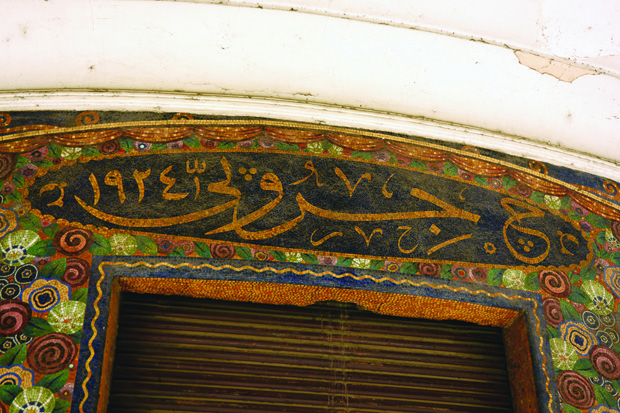 The Groppi building (detail).[/caption]
The Groppi building (detail).[/caption]
A small man dressed in black and wearing Giorgio Armani sunglasses was the fifth person to join the group. He was carrying two black bags, one that looked a bit like a camera bag and the other a laptop bag. Just a few moments later an Egyptian woman approached him and introduced a European man who was going to join the tour because it was his last day in Cairo. The man in black was obviously our tour guide. Ahmad al-Bendari has been giving this tour, and others, for about 14 years, he is now working with Al- Ismaelia for Real Estate Investment that aims to “revitalize the center of the capital city through preserving the architectural grandeur of downtown while celebrating Cairo’s dynamic urban fabric.” The company was founded in 2008 and so far owns 23 buildings in the downtown area.
Al-Bendari lit a cigarette and started giving out maps to all of the attendees. I was very impressed with the quality of the map — all the different tours given by Al-Ismaelia were color-coded, the names of the places visited were listed and pointed out in the map itself.
As we were waiting for more people to come, a policeman came and asked al-Bendari what we were doing, despite saying that he does know that there is a group that gathers every Friday at the same spot. Al-Bendari was very inviting, however, and told him with a smile what our exact route was going to be.
[caption id="attachment_501549" align="alignnone" width="413"]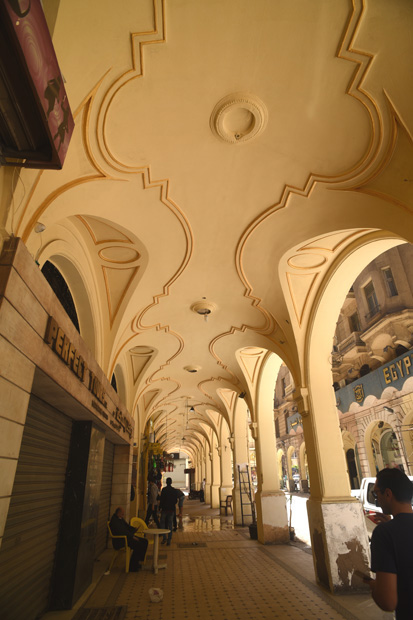 Baehler's Passage[/caption]
Baehler's Passage[/caption]
Around ten past nine, al-Bendari started to give a brief about Groppi and the surrounding area. The group was less than 30 people, mostly young Egyptians. But not everyone on the tour came because their professor recommended it. Quite a few of them were equipped with their professional cameras because they knew the gems they were about to witness, others were satisfied with their iPhones and selfie sticks.
Downtown is divided into two halves, Ismailia: named after Khedive Ismail, the fifth ruler of Egypt after Mohamed Ali who reigned from 1805-1952, and Al Tawfikia which is the new part of downtown. The year 1805 was when architecture and urban planning in Egypt began to change. Tahrir Square was previously called Midan El Ismailia after Khedive Ismail, but after the 1952 military coup, the name was changed.
I was surprised to learn that downtown used to be a residential area full of villas and gardens. But al-Bendari left nothing to the imagination and showed us pictures of several buildings in the area, one of them was the Savoy Hotel that used to be right across from Groppi on the left. In the early 20th century, downtown residents started moving out to Garden City, Zamalek and Maadi, but the one thing that hasn’t changed is that downtown still is a cultural hub; it might not be the go-to place for restaurants and upscale bars, but it is the destination for cultural events.
We turned our backs to Groppi and kept it on our right; we walked all the way down and stopped in front of the Automobile Club, which was renovated in 2002; inside it is the same but the façade has changed and is now neo-eclectic. Now, I am a person who appreciates beautiful architecture as much as beautiful people, but unfortunately that’s the only way I can describe a building; how beautiful or ugly it is. So when the tour guide said that the façade is now neo-eclectic, I did not have the slightest idea what he was referring to. And that was only the first of many instances throughout the tour! These are the club’s second premises; the first are on El Shawarby Street. Across from us was Estoril Restaurant that has been owned by the same family since its founding. A few middle-aged men were watching us, wondering what in the world we were doing walking around with cameras at 9 am.
[caption id="attachment_501552" align="alignnone" width="620"] The Immobilia Building[/caption]
The Immobilia Building[/caption]
We entered a pathway on the right of the club and there was a round yard with a non-working marble fountain in the middle, facing us was Abu Bakr El Sedik Mosque and on its left Le Grillon Restaurant. We went up a few steps on the right that led to a dark alley and stopped at an apartment building that al-Bendari said had an interesting foyer. All I could see was a very big chandelier but unfortunately the doorman wouldn’t allow us in the building or allow us to take photos!
We were out on the street again onto Mahmoud Bassiouny Street and our next stop was Hotel Viennoise. The building is sad and grey on the outside had a dirty marble staircase, with a nonfunctioning elevator with wooden doors. Al-Bendari greeted two men as we followed him in the building who seemed very indifferent to our presence. The building was designed in 1897 in neo-baroque style: On the inside it is very spacious, or it gives that feeling because of its high ceilings and because the only objects present are hanging lamps. There was an old elevator and a staircase with a metal rail wrapped around it. Going up one flight of stairs there was a window with colored glass, with the sunlight coming through the window and reflecting a shade of blue on both the metal rail and the marble floor. We all left the hotel with ample documentation of the blue sun’s rays and exited through the same door on Mahmoud Bassiouny Street, though we were told the hotel does have another door on Champollion Street.
The apartment building across the hotel features a Pharaonicstyle door and entrance. Again we were not allowed inside and this time the two big metal doors were chained. Al-Bendari said that in the past he used to come and enter freely on Fridays because that’s when the doorwoman or bawaba would go to church. Recently, however, she has stopped going to church just so she can stop al-Bendari and his groups wandering around her building. We peeped through the hole in the gate and tried to see the hall and steal photos.
We moved on to Mohamed Said Halim Palace, built between 1894 and 1899 and sometimes mistakenly called Champollion Palace. We were all standing facing the ediface, al-Bendari looking at us, which was his position whenever he was planning to show us pictures of the building in question.
[caption id="attachment_501553" align="alignnone" width="620"]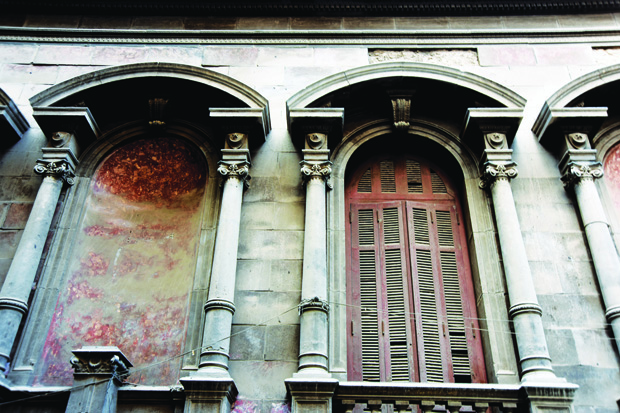 The Said Halim Palace, built between 1894 and 1899.[/caption]
The Said Halim Palace, built between 1894 and 1899.[/caption]
It used to have a garden reaching out to the other side of the street. At the time, the only other building in sight was Hotel Viennoise which would now only be visible from a balcony in one of the apartment buildings rising in between. Around 1932, a fence was built around the palace and the garden was built up. The Halim Palace was designed by an Italian architect who also worked on Abdeen Palace. This hotel’s style is the opposite of Art Deco; Art Nouveau, which takes many elements from the Pharaonic style. After WWII, the palace was turned into El Naserya Secondary School for Boys. Since 2004 it has been classified as a monument and is owned by business tycoon Rashad Osman.
To the right of the palace is Karim el-Dawla alley, the first building facing us was a Neo-Classical building erected in 1912. Ten years ago, the Townhouse Gallery opened, reviving the area. Al-Ismaelia Company owns the building and the gallery, Townhouse Shop, and Rawabet, a theater that used to be a garage.
Al-Ismaelia company, al-Bendari started explaining, wants to restore downtown to its ‘glory days,’ but demolishing and erecting buildings has always been part of our history: we renovate buildings in an attempt to bring back an era that no longer exists. The fact is the crème de la crème of society no longer live in downtown. They are now in New Cairo or Sixth of October. The people who can afford to live in these buildings are no longer interested in them. Al-Bendari all for renovating downtown but “without imposing the past in the present.”
After two hours of walking, it started to get warm, and by the time we arrived in front of Cinema Radio, al-Bendari had both of his sleeves rolled up and it was just me and him waiting for the rest of the group to join. Cinema Radio was built in the 1930s, its architectural designs both Art Deco and Modern. It was a new type of cinema at the time built after the cinemas in New York; today it retains its original façade with its distinctive ‘RADIO’ sign.
A big bodyguard stood to the side as al-Bendari was giving us a brief about the building, then made way for us to go inside. We went up black marble stairs to the cinema itself. Clearing a narrow staircase on the left we could see the cinema screen was facing us, the seats to our left. The cinema, which most recently played host to Bassem Youssef’s El Bernameg, is immense, seating up to 840 people.
We were allowed to take pictures of the cinema but not the theater — which was no real loss for us as the entrance, now part of the set for Abla Fahita — is a complete eyesore. The walls of the hall leading to the theater were purple with golden frames with the initials AF. The doors were red velvet and glittery. The décor on the theater was a huge doll house with different rooms and furniture in every compartment. All the seats where the audience would sit were covered with black satin. Both the theater and the cinema are now properties of El-Ismaelia company.
Our next stop was the the Catholic Armenian church, founded by an Armenian architect in 1926.
[caption id="attachment_501547" align="alignnone" width="413"] The Armenian Church[/caption]
The Armenian Church[/caption]
This church has a lot of metalwork and follows the Art Deco style. A building next to the church had an old Knorr advertisement painted on its side wall and which was one of al-Bendari’s suggested shots. Entering the church there were marble plates on either side of the door; one in French and one in Armenian, which I assume provide a brief history of the church.
It was around 11:45, and al-Bendari decided it was time for a break. We sat down in the church which was a great shelter from the afternoon sun, its colorful windows letting in very calming dim rays.
[caption id="attachment_501548" align="alignnone" width="413"] The Armenian Church[/caption]
The Armenian Church[/caption]
Al-Bendari sat on a bench facing us, his back to the altar as he talked about how the Greek, Italians and Armenians are part of the “fabric of Egyptian society” and not expatriates like the British and French who never had the intention of making Egypt their home. There are now 6,000 Armenians between Cairo and Alexandria. He named a few people whom we all consider Egyptian, but were originally from one of the three countries: Cleopatra who was originally Greek, and Shagar (and not Shagaret, as al-Bendari pointed out) El Dorr and Fayrouz the actress who were originally Armenian.
Walking out of the church, al-Bendari brought our attention to a bell ringing; it was from the nearby St. Joseph’s Roman Catholic Church. I honestly couldn’t hear the bell very clearly, but I couldn’t miss the mosque right next door to the church.
Our last stop was El Borsa. Al Sharifain Street has beautiful buildings on either side and palm trees down the middle. The Old Radio building and the Stock Market building are on the same side.
[caption id="attachment_501546" align="alignnone" width="413"] The Al Sharifein Radio Building[/caption]
The Al Sharifein Radio Building[/caption]
Our tour guide again knew the guards at the Stock Market building. We climbed about 20 marble stairs at the top of which was a trading room on one side and a lounge that’s being turned to a museum on the other. Standing in front of the trading room’s door, I was shocked to find ‘Egyption’ written above the door. However, I was quickly distracted when al-Bendari told the group that there was something we all had to see. He was very excited to show us what he could only describe as a “cute” elevator. It was a tiny, wooden elevator that I would personally be terrified to step into.
On the way down, one of the guards nonchalantly put out his cigarette on the floor with his half-worn shoe, which immediately reminded me of the spelling mistake. I told the guard how shameful it is that we can’t spell the word ‘Egyptian’ and that he should tell someone about it.
On Qasr el-Nil street, building number 11 is the Trieste building. It was now around 1:20 and al-Bendari’s voice was being drowned by the Friday prayer sermon. This building stands 87 meters high and was the tallest building in the area at the time. It was also the first to have a central heating system, an elevator and a garage. These are not the only reasons the building is famous, Leila Murad, Henry Barakat and many more celebrities lived in this building over the years.
From there we walked to Mostafa Kamel Square. The building behind the statue used to be the Risotto club and in the square are the first premises of Banque Misr — the first bank to with Egyptian shareholders and using Arabic as the official language of communication.
On the way to our last stop, a woman walked up to al-Bendari and started to ask what we were doing. As the tour guide explained, I thought about how Al-Ismaelia was renovating buildings to restore the ‘glory’ of downtown, and how this tour, on the ground, is putting us in touch with our history, and is intriguing pedestrians to ask about the nature of our group. The quick encounter with the woman also got me to think about how rare it is that we, as Egyptians, take walks, explore the city and enjoy ourselves. It is so rare that when a group of 20-something people walks around downtown, it actually turns heads and raises questions.
[caption id="attachment_501555" align="alignnone" width="620"]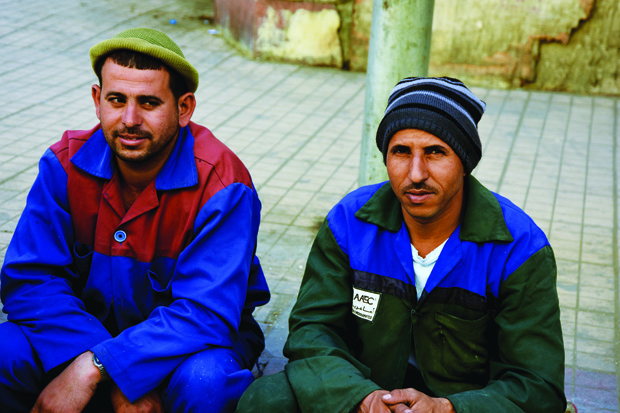 Street cleaners taking a break.[/caption]
Street cleaners taking a break.[/caption]
Al-Bendari bid us farewell on the other side of the Sephardic synagogue, which was designed in 1905. Across from the synagogue was the Kodak building with the first Kodak shop in the Middle East on its ground floor. This building, too, is owned by El-Ismaelia.
As I headed to my car with a smile on my face, I quickly found my phone in my purse, plugged in my earphones and played calming music to make my happy mood last a little while longer. The Friday prayer was coming to an end, the city was waking up and as I made my way through very light traffic, I tried to hold on to the memories of the Cairo I was introduced to this morning, until we meet again.
About Cairo D-Tour
Cairo D-Tour presents a new experience of Downtown Cairo, exploring its multiple points of interests, spaces of memory and heritage sites through a series of walking tours if the capital’s main streets and back alleys and revealing the historic significance behind its decaying structures. For schedules and more information, visit cairo-dtour.com.
[caption id="attachment_501554" align="alignnone" width="620"]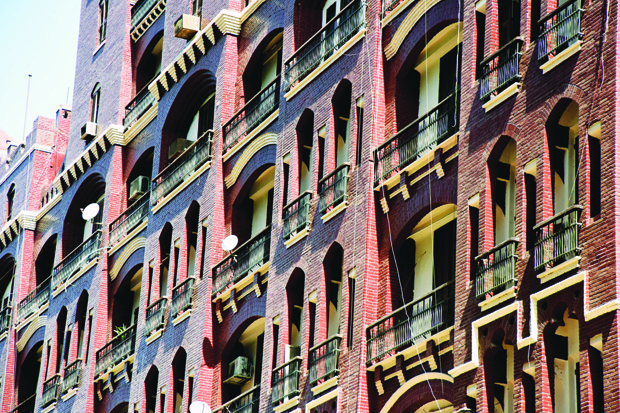 The Shorbagui Building[/caption]
The Shorbagui Building[/caption]
Comments
Leave a Comment